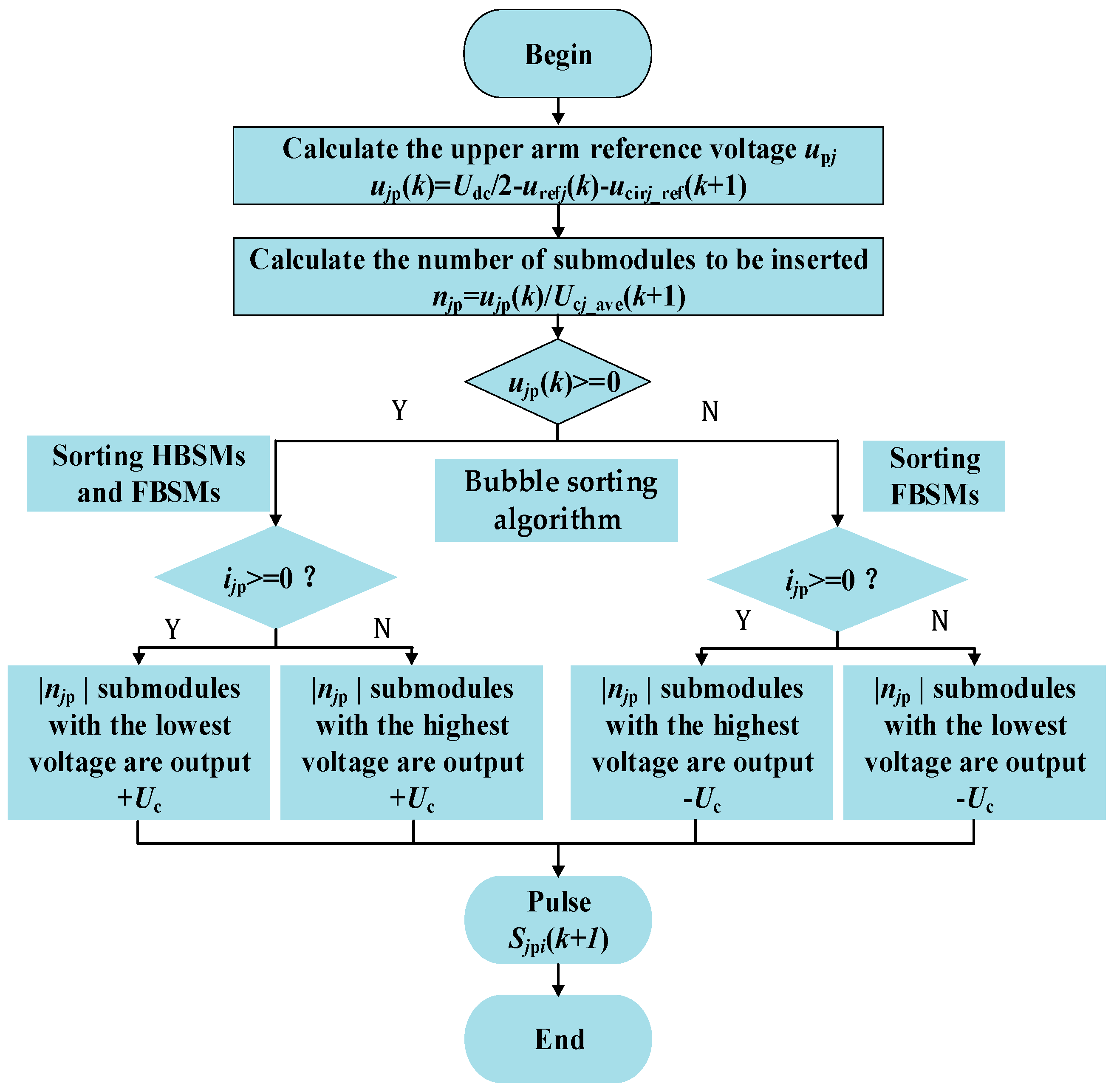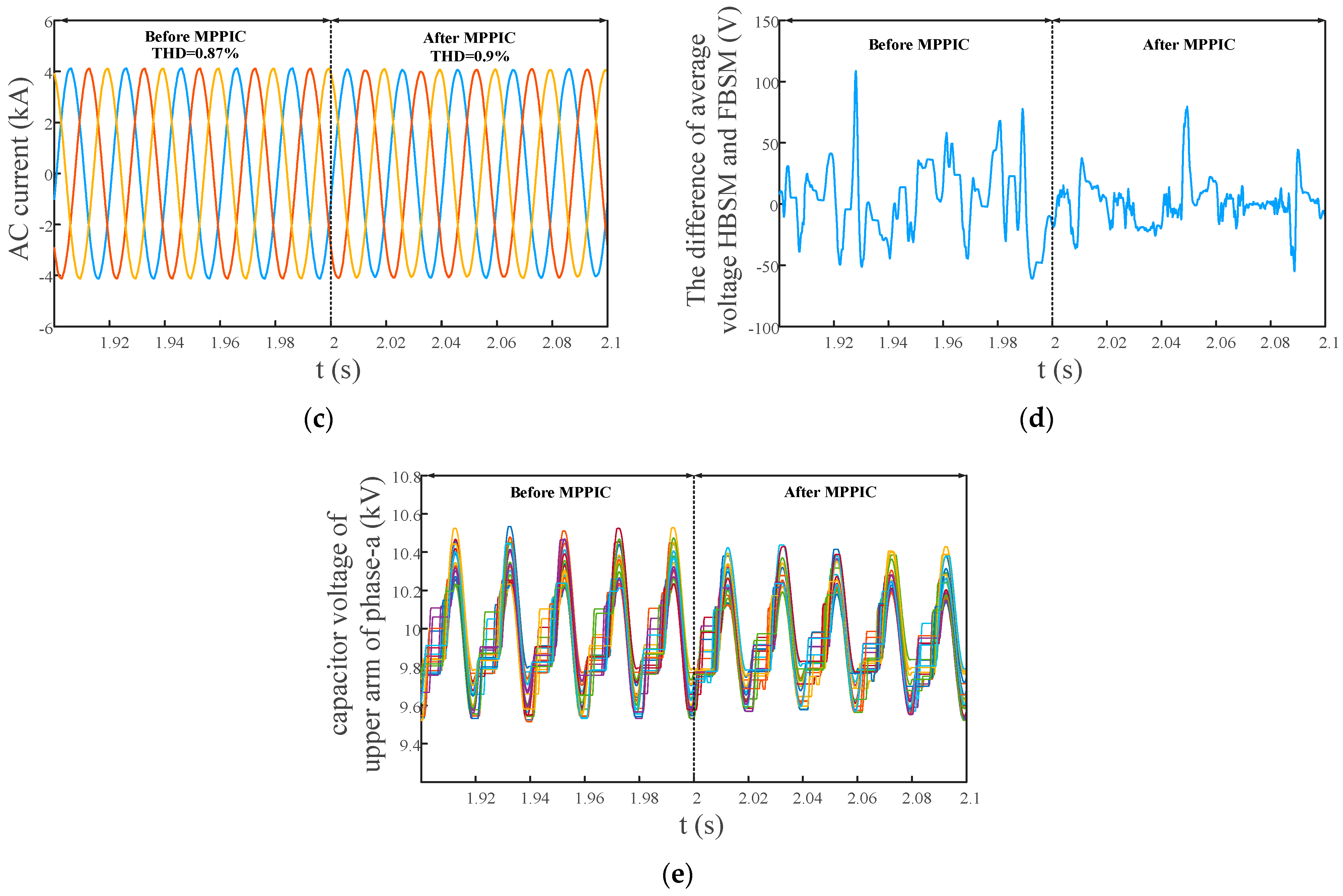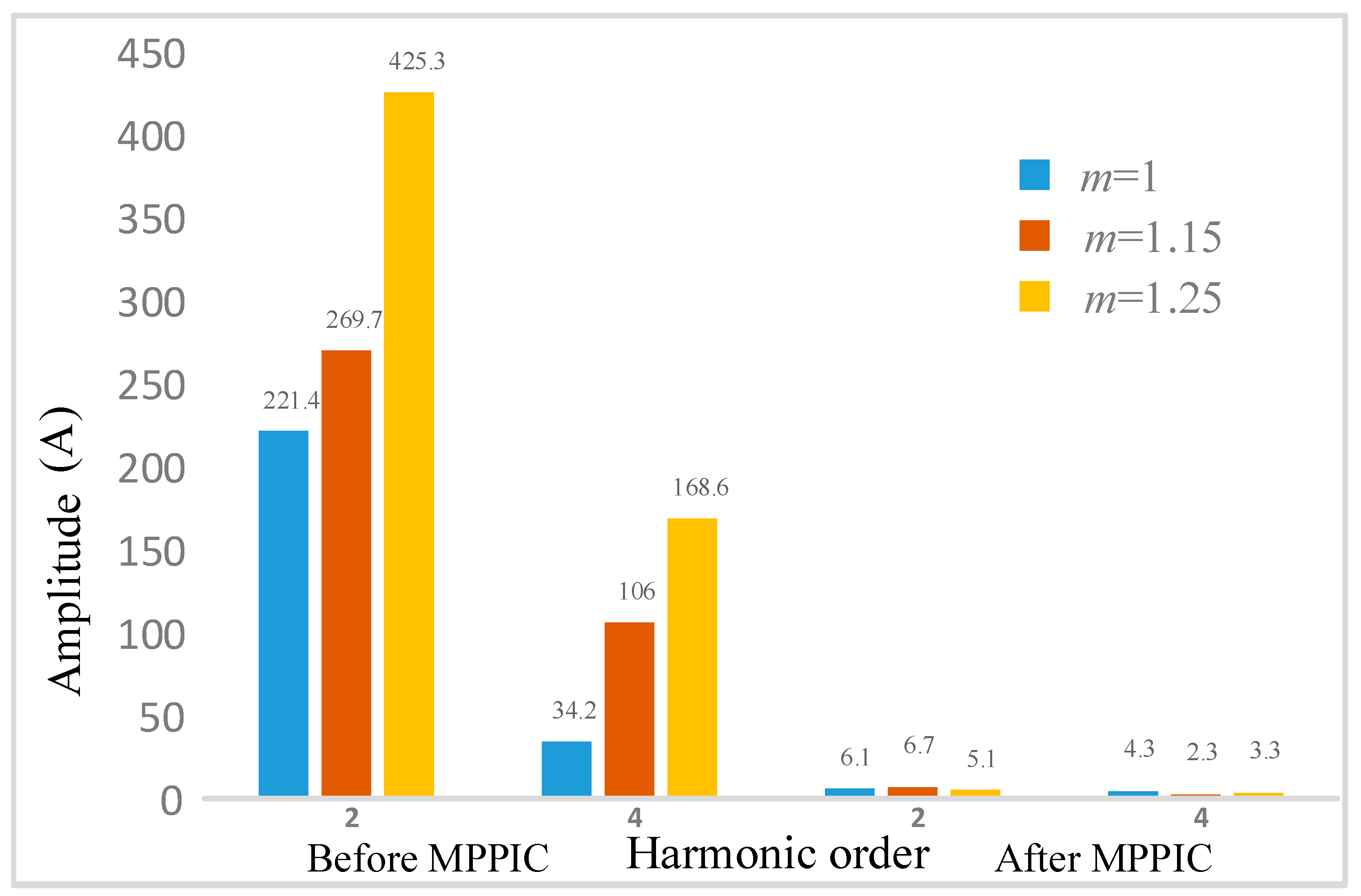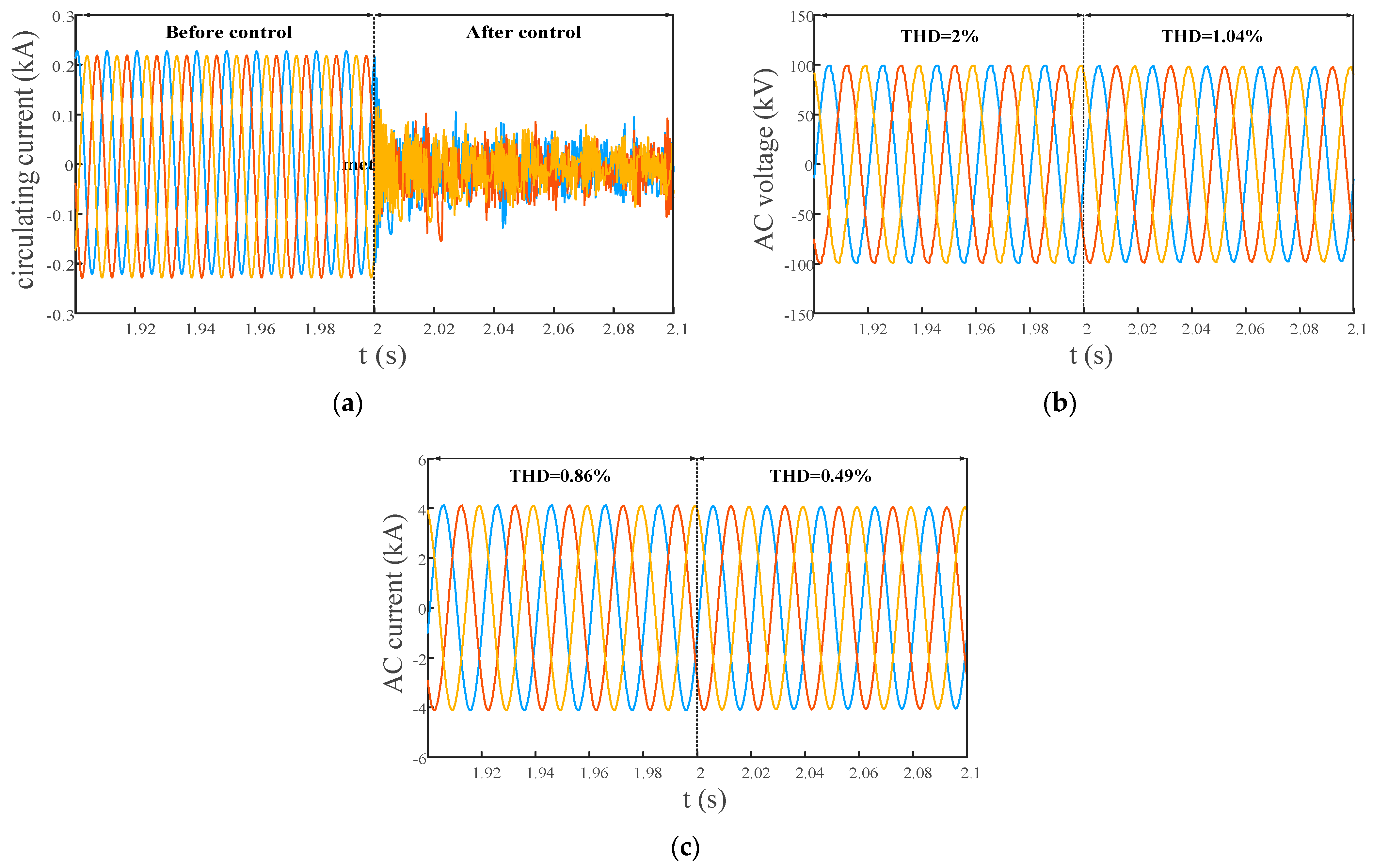Model Predictive PI Circulating Current Control for Modular Multilevel Converter
Abstract
:1. Introduction
2. Topology and Circulating Current Mathematical Model of MMC
2.1. Topology of Hybrid MMC
2.2. Circulating Current Harmonic Analysis
3. Model Predictive PI Circulating Current Control Strategy
3.1. Model Predictive PI Circulating Current Control Strategy
3.2. Predictive Model of MMC
3.3. PI Control
3.4. Sub-Module Capacitor Voltage Modulation and Balance Strategy
3.5. Comparison with Existing Circulating Current Control Methods
4. Simulations
5. Conclusions
Author Contributions
Funding
Data Availability Statement
Conflicts of Interest
References
- Dekka, A.; Wu, B.; Yaramasu, V.; Fuentes, R.L.; Zargari, N.R. Model Predictive Control of High-Power Modular Multilevel Converters—An Overview. IEEE J. Emerg. Sel. Top. Power Electron. 2018, 7, 168–183. [Google Scholar] [CrossRef]
- Zhihao, N.; Can, W.; Bin, Z.; Keren, Z.; Jian, Z.; Yonghai, X.; Guandong, Z.; Bin, R. Research on application of battery energy storage system based on MMC in wind power integration. In Proceedings of the 2017 IEEE Conference on Energy Internet and Energy System Integration (EI2), Beijing, China, 26–28 November 2017; pp. 1–6. [Google Scholar]
- Ma, Z.; Gao, F.; Gu, X.; Li, N.; Wu, Q.; Wang, X.; Wang, X. Multilayer SOH Equalization Scheme for MMC Battery Energy Storage System. IEEE Trans. Power Electron. 2020, 35, 13514–13527. [Google Scholar] [CrossRef]
- Zhao, B.; Song, Q.; Li, J.; Liu, W. A Modular Multilevel DC-Link Front-to-Front DC Solid-State Transformer Based on High-Frequency Dual Active Phase Shift for HVDC Grid Integration. IEEE Trans. Ind. Electron. 2016, 64, 8919–8927. [Google Scholar] [CrossRef]
- Zheng, G.; Chen, Y.; Kang, Y. A Modular Multilevel Converter (MMC) Based Solid-State Transformer (SST) Topology with Simplified Energy Conversion Process and Magnetic Integration. IEEE Trans. Ind. Electron. 2020, 68, 7725–7735. [Google Scholar] [CrossRef]
- Nakanishi, T.; Itoh, J.-I. High Power Density Design for a Modular Multilevel Converter With an H-Bridge Cell Based on a Volume Evaluation of Each Component. IEEE Trans. Power Electron. 2017, 33, 1967–1984. [Google Scholar] [CrossRef]
- Fuchs, S.; Biela, J. Reducing Losses and Energy Storage Requirements of Modular Multilevel Converters with Optimal Harmonic Injection. IEEE Access 2023, 11, 21283–21299. [Google Scholar] [CrossRef]
- Li, B.; Xu, Z.; Shi, S.; Xu, D.; Wang, W. Comparative Study of the Active and Passive Circulating Current Suppression Methods for Modular Multilevel Converters. IEEE Trans. Power Electron. 2017, 33, 1878–1883. [Google Scholar] [CrossRef]
- Tu, Q.; Xu, Z.; Xu, L. Reduced switching-frequency modulation and circulating current suppression for modular multilevel converters. IEEE Trans. Power Deliv. 2011, 26, 2009–2017. [Google Scholar]
- Bahrani, B.; Debnath, S.; Saeedifard, M. Circulating Current Suppression of the Modular Multilevel Converter in a Double-Frequency Rotating Reference Frame. IEEE Trans. Power Electron. 2015, 31, 783–792. [Google Scholar] [CrossRef]
- Li, S.; Wang, X.; Yao, Z.; Li, T.; Peng, Z. Circulating Current Suppressing Strategy for MMC-HVDC Based on Nonideal Proportional Resonant Controllers Under Unbalanced Grid Conditions. IEEE Trans. Power Electron. 2014, 30, 387–397. [Google Scholar] [CrossRef]
- Ye, T.; Dai, N.; Lam, C.S.; Wong, M.C.; Guerrero, J.M. Analysis design and implementation of a quasi-proportional-resonant controller for a multifunctional capacitive-coupling grid-connected inverter. IEEE Trans. Ind. Appl. 2016, 52, 4269–4280. [Google Scholar] [CrossRef] [Green Version]
- Isik, S.; Alharbi, M.; Bhattacharya, S. An Optimized Circulating Current Control Method Based on PR and PI Controller for MMC Applications. IEEE Trans. Ind. Appl. 2021, 57, 5074–5085. [Google Scholar] [CrossRef]
- He, L.; Zhang, K.; Xiong, J.; Fan, S. A Repetitive Control Scheme for Harmonic Suppression of Circulating Current in Modular Multilevel Converters. IEEE Trans. Power Electron. 2014, 30, 471–481. [Google Scholar] [CrossRef]
- Kolluri, S.; Gorla, N.B.Y.; Sapkota, R.; Panda, S.K. A New Control Architecture with Spatial Comb Filter and Spatial Repetitive Controller for Circulating Current Harmonics Elimination in a Droop-Regulated Modular Multilevel Converter for Wind Farm Application. IEEE Trans. Power Electron. 2019, 34, 10509–10523. [Google Scholar] [CrossRef]
- Yang, S.; Wang, P.; Tang, Y.; Zagrodnik, M.; Hu, X.; Tseng, K.J. Circulating Current Suppression in Modular Multilevel Converters with Even-Harmonic Repetitive Control. IEEE Trans. Ind. Appl. 2017, 54, 298–309. [Google Scholar] [CrossRef]
- Shen, K.; Zhao, D.; Chen, L.; Zhao, G.; Chen, W. A Time-Delayed Filter Based Suppression Method of Circulating Current in Modular Multilevel Converters. IEEE Trans. Ind. Electron. 2020, 68, 10309–10315. [Google Scholar] [CrossRef]
- Perez-Basante, A.; Ceballos, S.; Konstantinou, G.; Pou, J.; Andreu, J.; de Alegria, I.M. (2N+1) Selective Harmonic Elimination-PWM for Modular Multilevel Converters: A Generalized Formulation and A Circulating Current Control Method. IEEE Trans. Power Electron. 2017, 33, 802–818. [Google Scholar] [CrossRef]
- Chen, X.; Liu, J.; Song, S.; Ouyang, S. Circulating Harmonic Currents Suppression of Level-Increased NLM Based Modular Multilevel Converter with Deadbeat Control. IEEE Trans. Power Electron. 2020, 35, 11418–11429. [Google Scholar] [CrossRef]
- Wang, J.; Han, X.; Ma, H.; Bai, Z. Analysis and Injection Control of Circulating Current for Modular Multilevel Converters. IEEE Trans. Ind. Electron. 2018, 66, 2280–2290. [Google Scholar] [CrossRef]
- Fehr, H.; Gensior, A. Model-Based Circulating Current References for MMC Cell Voltage Ripple Reduction and Loss-Equivalent Arm Current Assessment. In Proceedings of the 2019 21st European Conference on Power Electronics and Applications (EPE ’19 ECCE Europe), Genova, Italy, 3–5 September 2019. [Google Scholar]
- Braeckle, D.; Himmelmann, P.; Gröll, L.; Hagenmeyer, V.; Hiller, M. Energy Pulsation Reduction in Modular Multilevel Converters Using Optimized Current Trajectories. IEEE Open J. Power Electron. 2021, 2, 171. [Google Scholar] [CrossRef]
- Ben-Brahim, L.; Gastli, A.; Trabelsi, M.; Ghazi, K.A.; Houchati, M.; Abu-Rub, H. Modular Multilevel Converter Circulating Current Reduction Using Model Predictive Control. IEEE Trans. Ind. Electron. 2016, 63, 3857–3866. [Google Scholar] [CrossRef]
- Yang, W.; Yao, F.; Zhou, Y. Voltage Ripple Suppression Methods for the Capacitor in Modular Multilevel Converter Submodules Employing a Reversed Pulse Width Modulation-Switching Channel. Electronics 2022, 11, 2193. [Google Scholar] [CrossRef]
- Li, M.; Chang, X.; Dong, N.; Liu, S.; Yang, H.; Zhao, R. Arm-Current-Based Model Predictive Control for Modular Multilevel Converter Under Unbalanced Grid Conditions. IEEE J. Emerg. Sel. Top. Power Electron. 2021, 10, 3195–3206. [Google Scholar] [CrossRef]
- Wu, W.; Qiu, L.; Rodriguez, J.; Liu, X.; Ma, J.; Fang, Y. Data-Driven Finite Control-Set Model Predictive Control for Modular Multilevel Converter. IEEE J. Emerg. Sel. Top. Power Electron. 2022, 11, 523–531. [Google Scholar] [CrossRef]
- Gao, S.; Huang, J.; Tong, X.; Jin, Y.; Liu, Z. A strategy of circulation current suppressing for modular multilevel converter based on model predictive control method. J. Beijing Jiaotong Univ. 2015, 5, 118–124. [Google Scholar]
- Jiang, Y.; Shu, H.; Liao, M. Fault-Tolerant Control Strategy for Sub-Modules Open-Circuit Fault of Modular Multilevel Converter. Electronics 2023, 12, 1080. [Google Scholar] [CrossRef]
- Zeng, R.; Xu, L.; Yao, L.; Morrow, D.J. Precharging and DC Fault Ride-Through of Hybrid MMC-Based HVDC Systems. IEEE Trans. Power Deliv. 2014, 30, 1298–1306. [Google Scholar] [CrossRef] [Green Version]
- Rao, N.P.; Shukla, A. Analysis of Capacitor Voltage Unbalance in Hybrid MMC and Its Novel Operation with Reduced Submodule Capacitance. IEEE J. Emerg. Sel. Top. Power Electron. 2022, 10, 7271–7284. [Google Scholar] [CrossRef]
- Xu, J.; Deng, W.; Gao, C.; Lu, F.; Liang, J.; Zhao, C.; Li, G. Dual Harmonic Injection for Reducing the Submodule Capacitor Voltage Ripples of Hybrid MMC. IEEE J. Emerg. Sel. Top. Power Electron. 2020, 9, 3622–3633. [Google Scholar] [CrossRef]










| Methods | Coordinate System | The Number of Controllers | Computation | Response Speed |
|---|---|---|---|---|
| PI | dq | 2 | light | quick |
| PR | αβ | 2 | light | quick |
| Injection | abc | 0 | light | quick |
| MPC | abc | 0 | heavy | slow |
| MPPI | abc | 3 | medium | medium |
| Item | Symbol | Value |
|---|---|---|
| DC voltage/kV | Udc | ±200 |
| Arm inductance/mH | Larm | 20 |
| The number of sub-modules in an arm | NH, NF | 10 + 10 |
| Sub-module capacitance/mF | C | 7 |
| Methods | Proposed MPPIC | Deadbeat Control | |||
|---|---|---|---|---|---|
| before | after | before | after | ||
| Circulating current (A) | 2-th | 221.4 | 6.1 | 224.2 | 21.6 |
| 4-th | 34.2 | 4.3 | 34.2 | 18.7 | |
| AC current (THD, %) | 0.87 | 0.86 | 0.86 | 0.49 | |
| AC voltage (THD, %) | 1.99 | 1.68 | 2 | 1.04 | |
Disclaimer/Publisher’s Note: The statements, opinions and data contained in all publications are solely those of the individual author(s) and contributor(s) and not of MDPI and/or the editor(s). MDPI and/or the editor(s) disclaim responsibility for any injury to people or property resulting from any ideas, methods, instructions or products referred to in the content. |
© 2023 by the authors. Licensee MDPI, Basel, Switzerland. This article is an open access article distributed under the terms and conditions of the Creative Commons Attribution (CC BY) license (https://creativecommons.org/licenses/by/4.0/).
Share and Cite
Jiang, Y.; Wang, W.; Shu, H.; Zhang, J. Model Predictive PI Circulating Current Control for Modular Multilevel Converter. Electronics 2023, 12, 2690. https://doi.org/10.3390/electronics12122690
Jiang Y, Wang W, Shu H, Zhang J. Model Predictive PI Circulating Current Control for Modular Multilevel Converter. Electronics. 2023; 12(12):2690. https://doi.org/10.3390/electronics12122690
Chicago/Turabian StyleJiang, Yaoxi, Wentao Wang, Hongchun Shu, and Junjie Zhang. 2023. "Model Predictive PI Circulating Current Control for Modular Multilevel Converter" Electronics 12, no. 12: 2690. https://doi.org/10.3390/electronics12122690




